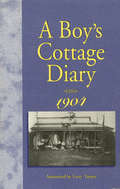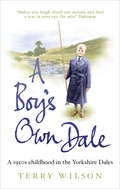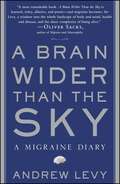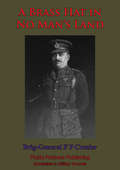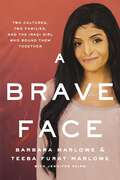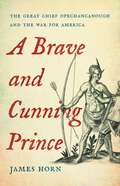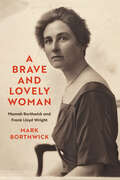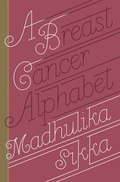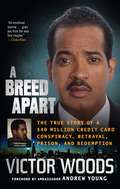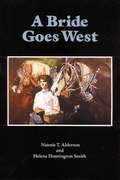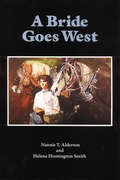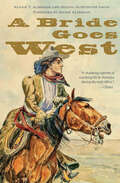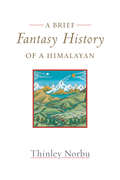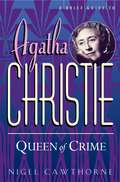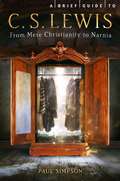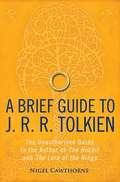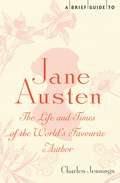- Table View
- List View
A Boy from Georgia: Coming of Age in the Segregated South (A\bradley Hale Fund For Southern Studies Publication)
by Hamilton Jordan&“The story of a young man waking to the fact that his family is on the wrong side of history.&”—Atlanta Journal-Constitution When Hamilton Jordan died in 2008, he left behind a mostly finished memoir. His daughter, Kathleen—with the help of her brothers and mother—took up the task of editing and completing the book. A Boy from Georgia—the result of this posthumous father-daughter collaboration—chronicles Hamilton Jordan&’s childhood in Albany, Georgia, charting his moral and intellectual development as he gradually discovers the complicated legacies of racism, religious intolerance, and southern politics, and affords his readers an intimate view of the state&’s wheelers and dealers. Jordan&’s middle-class childhood was bucolic in some ways and traumatizing in others. As Georgia politicians battled civil rights leaders, a young Hamilton straddled the uncomfortable line between the southern establishment to which he belonged and the movement in which he believed. Fortunate enough to grow up in a family that had considerable political clout within Georgia, Jordan eventually became a key aide to Jimmy Carter and was the architect of Carter&’s stunning victory in 1976, later serving as his chief of staff. Clear-eyed about the triumphs and tragedies of Jordan&’s beloved home state and region, A Boy from Georgia tells the story of a remarkable life in a voice that is witty, vivid, and honest. &“A delightful and inspiring coming-of-age story brimming with funny anecdotes, family mysteries, and political intrigue.&”—Hank Klibanoff, coauthor of The Race Beat: The Press, the Civil Rights Struggle, and the Awakening of a Nation
A Boy's Cottage Diary, 1904
by Fred Dickinson Larry TurnerFred Dickinson’s diary opens a window on youth and the world of Ontario lakeland cottages at the beginning of the 20th century."The stories we hand down, the diaries we preserve become the fabric of our social history. Young Fred Dickinson’s 1904 account of tenting and cottaging is a spirited first-hand sketch of a long-neglected part of our heritage. Larry Turner places the diary within social, historic and geographic contexts giving it wide appeal to history buffs of all ages …."- Julie Johnston, award-winning author
A Boy's Own Dale: A 1950s childhood in the Yorkshire Dales
by Terry WilsonGrowing up in rural Yorkshire in the 1940s and 50s, Terry Wilson spent his school days hunting down Just William books, cutting up apples to help with fractions and staring out the window dreaming up new schemes. But it was on the Dales themselves that Terry came into his own. Whether he was 'out-fishing' the adults with his homemade rod, grouse-beating for the lady of the manor, helping to bring in the farmers' hay in exchange for rabbit shooting rights, or growing his own prize caulis, his idiosyncratic and inventive mind is only matched by his love of nature. Told with affection, dry humour and a respect for the landscape and its people, through Terry's eyes we meet farmers, mill owners and 'gentlemen of the road'. Beautifully illustrated with newly-commissioned line-drawn illustrations by Don Grant, A Boy's Own Dale is a magical memoir of a long-lost world.
A Boy's Own Story: A Novel (Modern Library #47)
by Edmund White&“An extraordinary novel&” about growing up gay in the 1950s American Midwest (The New York Times Book Review). Critically lauded upon its initial publication in 1982 for its pioneering depiction of homosexuality, A Boy&’s Own Story is a moving tale about coming-of-age in midcentury America. With searing clarity and unabashed wit, Edmund White&’s unnamed protagonist yearns for what he knows to be shameful. He navigates an uneasy relationship with his father, confounds first loves, and faces disdain from his peers at school. In the embrace of another, he discovers the sincere and clumsy pleasures of adolescent sexuality. But for boys in the 1950s, these desires were unthinkable. Looking back on his experiences, the narrator notes, &“I see now that what I wanted was to be loved by men and to love them back but not to be a homosexual.&” From a winner of the PEN/Saul Bellow Award for Lifetime Achievement in Literature, this trailblazing autobiographical story of one boy&’s youth is a moving, tender, and heartbreaking portrait of what it means to grow up.
A Brain Wider Than the Sky: A Migraine Diary
by Andrew LevyWith more than one in ten Americans--and more than one in five families--affected, the phenomenon of migraine is widely prevalent yet often ignored or misdiagnosed. For Andrew Levy, his migraines were occasional reminders of a persistent illness that he'd wrestled with half his life. Then in 2006 Levy was struck almost daily by a series of debilitating migraines that kept him essentially bedridden for months, imprisoned by pain and nausea that retreated only briefly in gentler afternoon light. When possible, he kept careful track of what triggered an onset and in luminous prose recounts his struggle to live with migraines, his meticulous attempts at calibrating his lifestyle to combat and avoid them, and most tellingly, the personal relationship a migraineur develops--an almost Stockholm syndrome-like attachment--with the indescribable pain, delirium, and hallucinations. Levy researched how personalities and artists throughout history--Alexander Pope, Freud, Virginia Woolf, even Elvis--dealt with their migraines and candidly describes his rehabilitation with the aid of prescription drugs and his eventual reemergence into the world, back to work and writing. An enthralling blend of memoir and provocative analysis, A Brain Wider Than the Sky offers rich insights into an illness whose effects are too often discounted and whose sufferers are too often overlooked
A Brass Hat In No Man’s Land
by Brigadier Francis P. Crozier"Classic memoir of the Great War by a General who was not afraid to show his face in the front line - or even in No Man's Land.One of the best-known memoirs of the First World War written by a senior officer. The author served with the 9th Royal Irish (36th Ulster Div.) 1915-17 including the Somme Battles. And he commanded the 119th Inf. Bde. 1917-18. Crozier had the reputation of a hard-driving but hands-on CO who resorted to personally patrolling no-man's-land to obtain information. This book reflects his colourful personality."-N&M Print Edit.
A Brave Face: Two Cultures, Two Families, and the Iraqi Girl Who Bound Them Together
by Barbara Marlowe Teeba Furat MarloweThe inspirational story of a woman who moved mountains to provide medical care for an Iraqi girl badly burned during a roadside attack, Barbara Marlowe’s determination to fight for her future daughter highlights the way love can reach across both cultures and continents. Barbara Marlowe was in her fifties when she saw the photo that changed her life. It was a photo of four-year-old Teeba Furat Fadhil, whose face, head, and hands had been severely burned during a roadside bombing in the Diyala Province of Iraq when she was just nineteen months old. It was Teeba’s eyes that captivated Barbara. They were wide, dark, and soulful. They seemed to cry out with a message across continents: Help me.The story of Barbara responding to that call is as inspiring as it is improbable. With a powerful faith and determination, Barbara overcame obstacle after obstacle to bring Teeba to the United States for medical treatments—and to ultimately offer a home.A Brave Face includes material written by Teeba and her Iraqi mother, Dunia, at key moments in their stories. The book also explores the connection forged between Barbara and Dunia over the past decade—a connection that has survived the strife of war and the horrors of Al-Qaeda and ISIS. In the end, this story highlights the power of love to reach across both cultures and continents.
A Brave and Cunning Prince: The Great Chief Opechancanough and the War for America
by James HornThe extraordinary story of the Powhatan chief who waged a lifelong struggle to drive European settlers from his homelandIn the mid-sixteenth century, Spanish explorers in the Chesapeake Bay kidnapped an Indian child and took him back to Spain and subsequently to Mexico. The boy converted to Catholicism and after nearly a decade was able to return to his land with a group of Jesuits to establish a mission. Shortly after arriving, he organized a war party that killed them.In the years that followed, Opechancanough (as the English called him), helped establish the most powerful chiefdom in the mid-Atlantic region. When English settlers founded Virginia in 1607, he fought tirelessly to drive them away, leading to a series of wars that spanned the next forty years—the first Anglo-Indian wars in America— and came close to destroying the colony.A Brave and Cunning Prince is the first book to chronicle the life of this remarkable chief, exploring his early experiences of European society and his long struggle to save his people from conquest.
A Brave and Lovely Woman: Mamah Borthwick and Frank Lloyd Wright
by Mark BorthwickMamah Borthwick was an energetic, intelligent, and charismatic woman who earned a master’s degree at a time when few women even attended college, translated writings by a key figure of the early feminist movement, and taught at one of Germany’s best schools for boys. She is best known, however, as the mistress of the famous American architect Frank Lloyd Wright, and for her shocking murder at the renowned Wisconsin home he built for her, Taliesin. A Brave and Lovely Woman offers an important corrective to the narrative of Wright and Borthwick, a love story as American in character as it is Shakespearean in conclusion. Little of Wright’s life and work has been left untouched by his many admirers, critics, and biographers. And yet the woman who stood at the center of his emotional life, Mamah Borthwick, has fallen into near obscurity. Mark Borthwick—a distant relative—recenters Mamah Borthwick in her own life, presenting a detailed portrait of a fascinating woman, a complicated figure who was at once a dedicated mother and a faithless spouse, a feminist and a member of a conservative sorority, a vivacious extrovert and a social pariah. Careful research and engaging prose at last give Borthwick, an obscure but crucial character in one of America’s most famous tragedies, center stage.
A Breast Cancer Alphabet
by Madhulika SikkaA definitive and approachable guide to life during, and after, breast cancer The biggest risk factor for breast cancer is simply being a woman. Madhulika Sikka's A Breast Cancer Alphabet offers a new way to live with and plan past the hardest diagnosis that most women will ever receive: a personal, practical, and deeply informative look at the road from diagnosis to treatment and beyond.What Madhulika Sikka didn't foresee when initially diagnosed, and what this book brings to life so vividly, are the unexpected and minute challenges that make navigating the world of breast cancer all the trickier. A Breast Cancer Alphabet is an inspired reaction to what started as a personal predicament.This A-Z guide to living with breast cancer goes where so many fear to tread: sex (S is for Sex - really?), sentimentality (J is for Journey - it's a cliché we need to dispense with), hair (H is for Hair - yes, you can make a federal case of it) and work (Q is for Quitting - there'll be days when you feel like it). She draws an easy-to-follow, and quite memorable, map of her travels from breast cancer neophyte to seasoned veteran.As a prominent news executive, Madhulika had access to the most cutting edge data on the disease's reach and impact. At the same time, she craved the community of frank talk and personal insight that we rely on in life's toughest moments. This wonderfully inventive book navigates the world of science and story, bringing readers into Madhulika's mind and experience in a way that demystifies breast cancer and offers new hope for those living with it.From the Hardcover edition.
A Breed Apart: A Journey to Redemption
by Victor WoodsVictor Woods enjoyed a distinctly privileged childhood. Born to an affluent Chicago family -- the son of a Fortune 500 executive and a dedicated schoolteacher -- Woods attended all the best schools, and was never in want for anything. He lived safe in the bosom of a loving home. But like so many African Americans who came of age in post-segregation America, newly entitled to the benefits of racial integration, Woods felt alienated and enraged. Frustrated by the lack of positive enforcement in his predominantly white community and school system, and his well-intentioned tough-love parents, Woods, at age fifteen, ran away from home and didn't look back. Fascinated by street life and fast money, he turned to petty theft before graduating to armed robbery and credit-card manufacturing. At the height of his larceny, he had amassed forty million dollars' worth of counterfeit credit cards. His high-stakes grifting eventually got the attention of the law and landed him in prison. Six years later, he was released from prison, where many moments of truth brought him to the realization that crime does indeed not pay and he needed to change his life. Today Victor Woods stands as a man reborn, having dedicated his life and work to speaking to young people, motivating them to get on and stay on the straight and narrow. He tells his incredible story to help others sidestep the darkness and pain that once consumed him. In charting the winding path of his own hard-won journey toward redemption, Woods manages to reach out to readers with the startling emotional immediacy of a letter from an old friend. At once a bracing cautionary tale and a work sure to inspire readers from all walks, A Breed Apart is an invaluable work of penetrating honesty, depth, and passion.
A Bride Goes West
by Nannie T. Alderson Helena H. SmithA Bride Goes West is new and fresh because it is impregnated with a just sense of values about life. When Nannie Tiffany of West Virginia married Walt Alderson, who'd already been on the cattle trail for years, in 1882, they went to Montana to start a little ranch. There's plenty about ranching in this book but what is most valuable is about life, about people in this ranch country.
A Bride Goes West
by Nannie T. Alderson Helena Huntington SmithA Bride Goes West is new and fresh because it is impregnated with a just sense of values about life. When Nannie Tiffany of West Virginia married Walt Alderson, who'd already been on the cattle trail for years, in 1882, they went to Montana to start a little ranch. There's plenty about ranching in this book but what is most valuable is about life, about people in this ranch country.
A Bride Goes West (Bison Classic Editions)
by Nannie T. Alderson Helena Huntington SmithBlizzards, droughts, predators, unpredictable markets, and a host of other calamities tell the history of the daily struggles of Western ranching, and perhaps no one has told the story better than Nannie T. Alderson, a transplanted southern woman who married a cowboy and found herself in eastern Montana trying to build a ranching business a one-hundred-mile horse-and-buggy ride from the nearest town. Unfamiliar with even the most basic household chores, she soon found herself washing, cooking, riding, cleaning, branding, and a host of other ranch activities for which her upbringing had not prepared her. Although Nannie Alderson and her husband, Walt, would eventually move to Miles City, her story of the rigors of ranch life serves as the preeminent account of Montana ranch life and culture. This edition features a foreword from Nannie&’s great-grandniece, Jeanie Alderson, who ranches in the same area.
A Bridge Too Far?: Volume 4 (Air War Market Garden #4)
by Martin W. BowmanThis, the fourth and final volume of the series on Market-Garden in September 1944 reveals the final fate of the troops at Oosterbeek and the decision to evacuate all able bodied men in Operation 'Berlin' as well as the subsequent Operation 'Pegasus' when the Allies tried to return as many beleaguered troops back to Allied lines as possible. Was Arnhem indeed 'a bridge Too Far'? While 'Market-Garden' certainly was a heroic failure conducted at great cost it is debatable whether it contributed materially to the ultimate victory or was a foolish sacrifice of thousands of troops, aircrew and Dutch civilians in an ill-conceived assault on the German-held bridges across the Lower Rhine. There is no doubting the gritty, gallant and valorous contribution on the part of the British, Dominion, American and Polish paratroopers, the RAF and USAAF aircrews and their German opponents and Dutch civilians. Their incredible, illuminating and often under-stated accounts of extraordinary courage, camaraderie, shared terror and encounters with the enemy offer a more personalised view of 'Market-Garden' through the words of those who were there at the heart of the action. These tales are complemented by the author's background information supplemented by the inclusion of daily timelines that give an overall picture of each battle and air operation.
A Bridge for Passing: A Meditation on Love, Loss, and Faith (Los Jet De Plaza Y J Series)
by Pearl S. BuckThe Nobel Prize–winning and New York Times–bestselling author&’s memoir of making a movie in 1960s Japan, while mourning the loss of her husband. Pearl S. Buck&’s children&’s story, The Big Wave, about two young friends whose lives are transformed when a volcano erupts and a tidal wave engulfs their village, was eventually optioned as a movie. A Bridge for Passing narrates the resulting adventure, the story of the people involved in the movie-making process (including Polish director Tad Danielewski), their many complications while shooting, and the experience of working in Japan at a time when memories of the war remained strong. As much as all this, the book is a poignant reflection on personal crisis, and relates Buck&’s grief over the death of her husband of twenty-five years, Richard Walsh, who was also her editor. A Bridge for Passing offers an intimate view of postwar Japan mixed with Buck&’s heartrending meditation on loss and love. This ebook features an illustrated biography of Pearl S. Buck including rare images from the author&’s estate.
A Bridge to Justice: The Life of Franklin H. Williams
by Enid Gort John CaherDocuments the life of a gifted African American leader whose contributions were pivotal to the movement for social justice and racial equalityFranklin Hall Williams was a visionary and trailblazer who devoted his life to the pursuit of civil rights—not through acrimony and violence and hatred but through reason and example. A Bridge to Justice sheds new light on this practical, pragmatic bridge-builder and brilliant, complex individual whose life reflected the opportunities and constraints of an intellectually elite Black man in the twentieth century.Franklin H. Williams was considered a “bridge” figure, someone whose position outside the limelight allowed him to navigate both Black and white circles, span the more turbulent racial waters below, and persuade people to see the world in a new way. During his prolific lifetime, he was a civil rights leader, lawyer, diplomat, organizer of the Peace Corps, United Nations representative, foundation president, and associate of Thurgood Marshall on some of the seminal civil liberties cases of the past hundred years, though their relationship was so fraught with tension that Marshall had Williams sent to California. He worked in the Kennedy and Johnson administrations, served as a diplomat, and became an exceptionally persuasive advocate for civil rights. Even after enduring the segregated Army, suffering cruel discrimination, and barely escaping a murderous lynch mob eager to make him pay for zealously representing three innocent Black men falsely accused of rape, Franklin was not a hater. He believed that Americans, in general, were good people who were open to reason and, in their hearts, sympathetic to fairness and justice.Dr. Enid Gort, an anthropologist and Africanist who conducted hundreds of hours of exclusive interviews with Williams, his family, friends, colleagues, and compatriots, and John M. Caher, a professional writer and legal journalist, have co-written an exhaustively researched and scrupulously documented account of this civil rights champion’s life and impact. His story is an object lesson to help this nation heal and advance through unity rather than tribalism.
A Brief Fantasy History of a Himalayan
by Thinley NorbuPersonal reminiscences of an esteemed Tibetan Buddhist master, ranging from touching memoir to humorous storytelling, from sharp cultural commentary to deeply felt verse--illustrated with rare photos in full color. Illustrated with color photos published for the first time, this collage of reminiscences affords a rare glimpse into the life of an esteemed Tibetan Buddhist teacher. The author sets a magical mood as he describes his early years in "Snowland" (Tibet) as one of seven children of a renowned Nyingma master. Thinley Norbu Rinpoche's storytelling alternates earthy humor with poetic sensitivity and tender sensuality. Describing his travels in Asia, Europe, and America, he presents thumbnail sketches of people and places, as well as sharp-sighted commentary on Western cultural trends and Dharma students' positive and negative qualities. More than just an autobiography, this written offering is an expression of Rinpoche's wisdom, compassion, and personal realization.
A Brief Guide To Agatha Christie
by Nigel CawthorneAgatha Christie?s 80 novels and short-story collections have sold over 2 billion copies in more than 45 languages, more than any other author. When Christie finally killed off her Belgian detective, Hercule Poirot, the year before she herself died, that `detestable, bombastic, tiresome, ego-centric little creep? in Christie?s words, received a full-page obituary in the New York Times, the only fictional character ever to have done so. From her first novel, The Mysterious Affair at Styles, a Poirot mystery, to her last, Sleeping Murder, featuring Miss Marple, Crawford explores Christie?s life and fiction. Cawthorne examines recurring characters, such as Captain Arthur Hastings, Poirot?s Dr Watson; Chief Inspector Japp, his Lestrade, as well as other flat-footed policemen that Poirot outsmarts on his travels; his efficient secretary, Miss Felicity Lemon; another employee, George; and Ariadne Oliver, a humorous caricature of Christie herself. He looks at the writer?s own fascinating: her work as a nurse during the First World War; her strange disappearance after her first husband asked for a divorce; and her exotic expeditions with her second husband, the archaeologist Sir Max Mallowan. He examines the author?s working life ? her inspirations, methods and oeuvre ? and provides biographies of her key characters, their attire, habits and methods, including Poirot?s relationships with women, particularly Countess Vera Rossakoff and Miss Amy Carnaby. In doing so, he sheds light on the genteel world of the country house and the Grand Tour between the wars. He takes a look at the numerous adaptations of Christie?s stories for stage and screen, especially Poirot?s new life in the eponymous long-running and very successful TV series.
A Brief Guide To Agatha Christie (Brief Histories)
by Nigel CawthorneAgatha Christie’s 80 novels and short-story collections have sold over 2 billion copies in more than 45 languages, more than any other author. When Christie finally killed off her Belgian detective, Hercule Poirot, the year before she herself died, that ‘detestable, bombastic, tiresome, ego-centric little creep’ in Christie’s words, received a full-page obituary in the New York Times, the only fictional character ever to have done so. From her first novel, The Mysterious Affair at Styles, a Poirot mystery, to her last, Sleeping Murder, featuring Miss Marple, Crawford explores Christie’s life and fiction. Cawthorne examines recurring characters, such as Captain Arthur Hastings, Poirot’s Dr Watson; Chief Inspector Japp, his Lestrade, as well as other flat-footed policemen that Poirot outsmarts on his travels; his efficient secretary, Miss Felicity Lemon; another employee, George; and Ariadne Oliver, a humorous caricature of Christie herself. He looks at the writer’s own fascinating: her work as a nurse during the First World War; her strange disappearance after her first husband asked for a divorce; and her exotic expeditions with her second husband, the archaeologist Sir Max Mallowan. He examines the author’s working life – her inspirations, methods and oeuvre – and provides biographies of her key characters, their attire, habits and methods, including Poirot’s relationships with women, particularly Countess Vera Rossakoff and Miss Amy Carnaby. In doing so, he sheds light on the genteel world of the country house and the Grand Tour between the wars. He takes a look at the numerous adaptations of Christie’s stories for stage and screen, especially Poirot’s new life in the eponymous long-running and very successful TV series.
A Brief Guide to C. S. Lewis: From Mere Christianity to Narnia
by Paul SimpsonNovember 2013 marks the 50th anniversary of the death of Clive Staples 'Jack' Lewis, when a memorial to him will be placed in Poet's Corner in Westminster Abbey. Although perhaps best known as the author of the seven Chronicles of Narnia, published between 1949 and 1954, Lewis also wrote The Pilgrim's Regress, a trilogy of science-fiction novels incorporating Christian themes, and a large number of non-fiction books about his faith, accessible to Christians and non-believers alike. In a survey of the greatest British writers since 1945, the Times newspaper ranked Lewis eleventh, ahead of Salman Rushdie, Anthony Burgess and Ian Fleming.A Brief Guide to C. S. Lewis explores Lewis's life, from his reconversion to Christianity under the influence of his friend J. R. R. Tolkien, which had such a profound influence on his writing - both fiction and non-fiction - to his marriage to American writer Joy Davidman Gresham and his battle with cancer. He died on 22 November 1963, a day before the first-ever episode of Dr Who, a TV series with many links to his Narnia stories was shown. Although this Brief Guide ranges well beyond the world of Narnia to explore other aspects of Lewis's life and his other writings, it does not do so - unusually among books on Lewis - from the point of view of Christian scholarship, thereby assuming much knowledge of theology on the part of readers. That Lewis wrote about the problems of praying is significant; the specific texts he discusses and dissects are likely to be of less significance to most readers.The guide provides synopses of Lewis's fiction, an overview of his other writings, a biography and a look at all the many different versions of his stories that have appeared. In doing so it draws on recent interviews by the author with some of the many talented people who have worked on these adaptations.
A Brief Guide to C. S. Lewis: From Mere Christianity to Narnia (Brief Histories)
by Paul SimpsonNovember 2013 marks the 50th anniversary of the death of Clive Staples 'Jack' Lewis, when a memorial to him will be placed in Poet's Corner in Westminster Abbey. Although perhaps best known as the author of the seven Chronicles of Narnia, published between 1949 and 1954, Lewis also wrote The Pilgrim's Regress, a trilogy of science-fiction novels incorporating Christian themes, and a large number of non-fiction books about his faith, accessible to Christians and non-believers alike. In a survey of the greatest British writers since 1945, the Times newspaper ranked Lewis eleventh, ahead of Salman Rushdie, Anthony Burgess and Ian Fleming.A Brief Guide to C. S. Lewis explores Lewis's life, from his reconversion to Christianity under the influence of his friend J. R. R. Tolkien, which had such a profound influence on his writing - both fiction and non-fiction - to his marriage to American writer Joy Davidman Gresham and his battle with cancer. He died on 22 November 1963, a day before the first-ever episode of Dr Who, a TV series with many links to his Narnia stories was shown. Although this Brief Guide ranges well beyond the world of Narnia to explore other aspects of Lewis's life and his other writings, it does not do so - unusually among books on Lewis - from the point of view of Christian scholarship, thereby assuming much knowledge of theology on the part of readers. That Lewis wrote about the problems of praying is significant; the specific texts he discusses and dissects are likely to be of less significance to most readers.The guide provides synopses of Lewis's fiction, an overview of his other writings, a biography and a look at all the many different versions of his stories that have appeared. In doing so it draws on recent interviews by the author with some of the many talented people who have worked on these adaptations.
A Brief Guide to J. R. R. Tolkien: A comprehensive introduction to the author of The Hobbit and The Lord of the Rings (Brief Histories)
by Nigel CawthorneA very readable overview of Tolkien and his work, incorporating a brief biography, an examination of the books and a look at the process of filming his work, including The Hobbit and The Lord of the Rings saga. It explores how Tolkien's background as a medievalist and linguist informed the languages of Middle-earth, the influence of his Catholicism and Tolkien's legacy in fantasy.A timely book to coincide with the first of Peter Jackson's two keenly awaited Hobbit films.
A Brief Guide to Jane Austen: The Life And Times Of The World's Favourite Author
by Charles JenningsJane Austen is a mystery. The first incontrovertibly great woman novelist, she is, among other things, one of the finest prose stylists in literature; the first truly modern writer, the Godmother of chick lit. She is also the greatest enigma (next to Shakespeare) in English literature. Soldiers in the First World War sat in the trenches and read them for the civilising comforts they provided. Hard-nut literary critics such as F. R. Leavis lauded their austere complexity. World Book Day, 2007, found that Pride and Prejudice was the one book 'The nation can't live without'.In this witty, accessible guide, Charles Jennings goes in search of this enigma through her words as well as her times, including a short biography, an overview of the novels, as well as the world that she inhabited. Finally, the book contains Jane's very own words of advice for the modern life.
A Brief Guide to Jane Austen: The Life and Times of the World's Favourite Author (Brief Histories)
by Charles JenningsJane Austen is a mystery. The first incontrovertibly great woman novelist, she is, among other things, one of the finest prose stylists in literature; the first truly modern writer, the Godmother of chick lit. She is also the greatest enigma (next to Shakespeare) in English literature. Soldiers in the First World War sat in the trenches and read them for the civilising comforts they provided. Hard-nut literary critics such as F. R. Leavis lauded their austere complexity. World Book Day, 2007, found that Pride and Prejudice was the one book 'The nation can't live without'.In this witty, accessible guide, Charles Jennings goes in search of this enigma through her words as well as her times, including a short biography, an overview of the novels, as well as the world that she inhabited. Finally, the book contains Jane's very own words of advice for the modern life.

